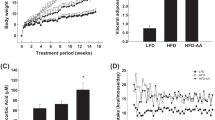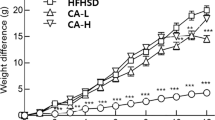Abstract
A combination of selenium (Se) with other trace element is associated with partially modulate fatty acid distribution as well as reduction of the body weight and feed efficiency. To investigate whether or not Se treatment has an impact on lipid metabolism, we examined the levels of lipid metabolism-related factors, including abdominal fat, adiponectin, cholesterol, very long chain dehydrogenase (VLCAD), and medium chain acyl-CoA dehydrogenase (MCAD) in 20-week-old Otsuka Long-Evans Tokushima Fatty (OLETF) rats following sodium selenite treatment for 2 weeks. Herein, we observed that (a) Se treatment induced insulin-like effects by lowering the serum glucose level in rats; (b) Se-treated rats showed significance values decreases in abdominal fat mass, adipocyte size, and adiponectin, which are associated with lipid metabolism; (c) Se treatment led to reduced levels of cholesterol, triglycerides, low-density lipoprotein (LDL), and high-density lipoprotein (HDL) cholesterol; (d) fat tissue in Se-treated rats displayed significantly lower expression of adipocyte marker genes along with increased expression of VLCAD and MCAD; and (e) fatty liver formation and β-oxidation gene expression were both significantly reduced in liver tissue of Se-treated rats. Therefore, our results suggest that Se may induce inhibition of adipocyte hypertrophy and abdominal fat accumulation along with suppression of fatty liver formation by the differential regulation of the gene expression for fatty acid β-oxidation in the OLETF model.





Similar content being viewed by others
References
Rayman MP (2000) The importance of selenium to human health. Lancet 356:233–241
Rayman MP (2009) Selenoproteins and human health: insights from epidemiological data. Biochim Biophys Acta 1790:1533–1540
Jackson MI, Combs GF Jr (2008) Selenium and anticarcinogenesis: underlying mechanisms. Curr Opin Clin Nutr Metab Care 11:718–726
Selenius M, Rundlöf AK, Olm E, Fernandes AP, Björnstedt M (2010) Selenium and the selenoprotein thioredoxin reductase in the prevention, treatment and diagnostics of cancer. Antioxid Redox Signal 12:867–880
Stranges S, Marshall JR, Natarajan R, Donahue RP, Trevisan M, Combs GF, Cappuccio FP, Ceriello A, Reid ME (2007) Effects of long-term selenium supplementation on the incidence of type 2 diabetes: a randomized trial. Ann Intern Med 147:217–223
Duntas LH (2009) Selenium and inflammation: underlying anti-inflammatory mechanisms. Horm Metab Res 41:443–447
McNeill JH, Delgatty HL, Battell ML (1991) Insulinlike effects of sodium selenite in streptozotocin-induced diabetic rats. Diabetes 40:1675–1678
Naziroğlu M (2003) Enhanced testicular antioxidant capacity in streptozotocin-induced diabetic rats Protective role of vitamins C and E and selenium. Biol Trace Elem Res 94:61–72
Beaker DJ, Reul B, Ozcelikay AT, Buchet JP, Henquin JC, Brichard SM (1996) Oral selenate improves glucose homeostasis and partly reverses abnormal expression of liver glycolytic and gluconeogenic enzymes in diabetic rats. Diabetologia 39:3–11
Battell ML, Delgatty HL, McNeill JH (1998) Sodium selenite corrects glucose tolerance and heart function in STZ diabetic rats. Mol Cell Biochem 179:27–34
Ghose A, Fleming J, Harrison PR (2001) Selenium and signal transduction: roads to cell death and anti-tumor activity. Biofactors 14:127–133
Ayaz M, Can B, Ozdemir S, Turan B (2002) Protective effect of selenium treatment on diabetes-induced myocardial structural alterations. Biol Trace Elem Res 89:215–226
Ayaz M, Ozdemir S, Ugur M, Vassort G, Turan B (2004) Effects of selenium on altered mechanical and electrical cardiac activities of diabetic rat. Arch Biochem Biophys 426:83–90
Hei YJ, Farahbakshian S, Chen X, Battell ML, McNeill JH (1998) Stimulation of MAP kinase and S6 kinase by vanadium and selenium in rat adipocytes. Mol Cell Biochem 178:367–375
McKenize RC, Arthur JR, Miller SM, Rafferty TS, Beckett GJ (2002) Selenium and immune function. In: Calder PC, Field CJ, Gill HS (eds) Nutrition and immune function. CABI Publishing, Wallingford, pp 229–250
Ezaki O (1990) The insulin-like effects of selenate in rat adipocytes. J Biol Chem 265:1124–1128
Douillet C, Bost M, Accominotti M, Borson-Chazot F, Ciavatti M (1998) Effect of selenium and vitamin E supplementation on lipid abnormalities in plasma, aorta, and adipose tissue of Zucker rats. Biol Trace Elem Res 65:221–236
Bock BC, Kanarek RB, Aprille JR (1995) Mineral content of the diet alters sucrose-induced obesity in rats. Physiol Behav 57:659–668
Kawano K, Hirashima T, Mori S, Natori T (1994) OLETF (Otsuka Long-Evans Tokushima Fatty) rat: a new NIDDM rat strain. Diabetes Res Clin Pract 24:S317–S320
Moran TH (2008) Unraveling the obesity of OLETF rats. Physiol Behav 94:71–78
Mori YY (1999) Similarity and dissimilarity between the OLETF rats and obese individuals with NIDDM. Elsevier, Amsterdam
Hwang D, Seo S, Kim Y, Kim C, Shim S, Jee S, Lee S, Jang M, Kim M, Yim S, Lee SK, Kang B, Jang I, Cho J (2007) Selenium acts as an insulin-like molecule for the down-regulation of diabetic symptoms via endoplasmic reticulum stress and insulin signalling proteins in diabetes-induced non-obese diabetic mice. J Biosci 32(4):723–735
Shin SS, Jung YS, Yoon KH, Choi S, Hong Y, Park D, Lee H, Seo BI, Lee HY, Yoon M (2010) The Korean traditional medicine gyeongshingangjeehwan inhibits adipocyte hypertrophy and visceral adipose tissue accumulation by activating PPARalpha actions in rat white adipose tissues. J Ethnopharmacol 127:47–54
Arita Y, Kihara S, Ouchi N, Takahashi M, Maeda K, Miyagawa J, Hotta K, Shimomura I, Nakamura T, Miyaoka K, Kuriyama H, Nishida M, Yamashita S, Okubo K, Matsubara K, Muraguchi M, Ohmoto Y, Funahashi T, Matsuzawa Y (1999) Paradoxical decrease of an adipose-specific protein, adiponectin, in obesity. Biochem Biophys Res Commun 257:79–83
Yang WS, Jeng CY, Wu TJ, Tanaka S, Funahashi T, Matsuzawa Y, Wang JP, Chen CL, Tai TY, Chuang LM (2002) Synthetic peroxisome proliferator-activated receptor-gamma agonist, rosiglitazone, increases plasma levels of adiponectin in type 2 diabetic patients. Diabetes Care 25:376–380
Yu JG, Javorschi S, Hevener AL, Kruszynska YT, Norman RA, Sinha M, Olefsky JM (2002) The effect of thiazolidinediones on plasma adiponectin levels in normal, obese, and type 2 diabetic subjects. Diabetes 51:2968–2974
Roy S, Dontamalla SK, Mondru AK, Sannigrahi S, Veerareddy PR (2011) Downregulation of apoptosis and modulation of TGF-β1 by sodium selenate prevents streptozotocin-induced diabetic rat renal impairment. Biol Trace Elem Res 139:55–71
Kim JJ, Wang M, Paschke R (1993) Crystal structures of medium-chain acyl-CoA dehydrogenase from pig liver mitochondria with and without substrate. Proc Natl Acad Sci USA 90:7523–7527
Stapleton SR (2000) Selenium: an insulin-mimetic. Cell Mol Life Sci 57:1874–1879
Fürnsinn C, Englisch R, Ebner K, Nowotny P, Vogl C, Waldhäusl W (1996) Insulin-like vs. non-insulin-like stimulation of glucose metabolism by vanadium, tungsten, and selenium compounds in rat muscle. Life Sci 59:1989–2000
Heart E, Sung CK (2003) Insulin-like and non-insulin-like selenium actions in 3T3-L1 adipocytes. J Cell Biochem 88:719–731
Wayland M, Gilchrist HG, Marchant T, Keating J, Smits JE (2002) Immune function, stress response, and body condition in arctic-breeding common eiders in relation to cadmium, mercury, and selenium concentrations. Environ Res 90:47–60
Diez JJ, Iglesias P (2003) The role of the novel adipocyte-derived hormone adiponectin in human disease. Eur J Endocrinol 148:293–300
Ukkola O, Santaniemi M (2002) Adiponectin: a link between excess adiposity and associated comorbidities? J Mol Med 80:696–702
Coppola A, Marfella R, Coppola L, Tagliamonte E, Fontana D, Liguori E, Cirillo T, Cafiero M, Natale S, Astarita C (2008) Effect of weight loss on coronary circulation and adiponectin levels in obese women. Int J Cardiol 134:414–416
Pemberton PW, Ahmad Y, Bodill H, Lokko D, Hider SL, Yates AP, Walker MG, Laing I, Bruce IN (2009) Biomarkers of oxidant stress, insulin sensitivity and endothelial activation in rheumatoid arthritis: a cross-sectional study of their association with accelerated atherosclerosis. BMC Res Notes 2:83
Murthy NS, Mukherjee S, Ray G, Ray A (2009) Dietary factors and cancer chemoprevention: an overview of obesity-related malignancies. J Postgrad Med 55:45–54
Kaur HD, Bansal MP (2009) Studies on HDL associated enzymes under experimental hypercholesterolemia: possible modulation on selenium supplementation. Lipids Health Dis 8:55
Cay M, Naziroglu M, Koylu H (2009) Selenium and vitamin E modulates cigarette smoke exposure-induced oxidative stress in blood of rats. Biol Trace Elem Res 131:62–70
Ji H, Friedman MI (2007) Reduced capacity for fatty acid oxidation in rats with inherited susceptibility to diet-induced obesity. Metabolism 56:1124–1130
Murase T, Aoki M, Tokimitsu I (2005) Supplementation with alpha-linolenic acid-rich diacylglycerol suppresses fatty liver formation accompanied by an up-regulation of beta-oxidation in Zucker fatty rats. Biochim Biophys Acta 1733:224–231
Zhao LY, Xu SQ, Zhao RQ, Peng ZQ, Pan XJ (2009) Effects of selenium and methionine supplementation of breeder hen diets on selenium concentration and oxidative stability of lipids in the thigh muscles of progeny. J Food Sci 74:C569–C574
Menéndez-Carreño M, Ansorena D, Milagro FI, Campión J, Martínez JA, Astiasarán I (2008) Inhibition of serum cholesterol oxidation by dietary vitamin C and selenium intake in high fat fed rats. Lipids 43:383–390
Uğuz AC, Nazıroğlu M (2012) Effects of selenium on calcium signaling and apoptosis in rat dorsal root ganglion neurons induced by oxidative stress. Neurochem Res 37:1631–1638
Koistinaho J, Alho H, Hervonen A (1990) Effect of vitamin E and selenium supplement on the aging peripheral neurons of the male Sprague–Dawley rat. Mech Ageing Dev 51:63–72
Acknowledgment
We would like to thank Jin Hyang Hwang, the animal technicians, for directing the Animal Facility and Care at the Laboratory Animal Resources Center. This research was supported by a grant from Regional Innovation System (RIS) of the Ministry of Knowledge Economy in Korea.
Author information
Authors and Affiliations
Corresponding author
Rights and permissions
About this article
Cite this article
Kim, J.E., Choi, S.I., Lee, H.R. et al. Selenium Significantly Inhibits Adipocyte Hypertrophy and Abdominal Fat Accumulation in OLETF Rats via Induction of Fatty Acid β-Oxidation. Biol Trace Elem Res 150, 360–370 (2012). https://doi.org/10.1007/s12011-012-9519-1
Received:
Accepted:
Published:
Issue Date:
DOI: https://doi.org/10.1007/s12011-012-9519-1




